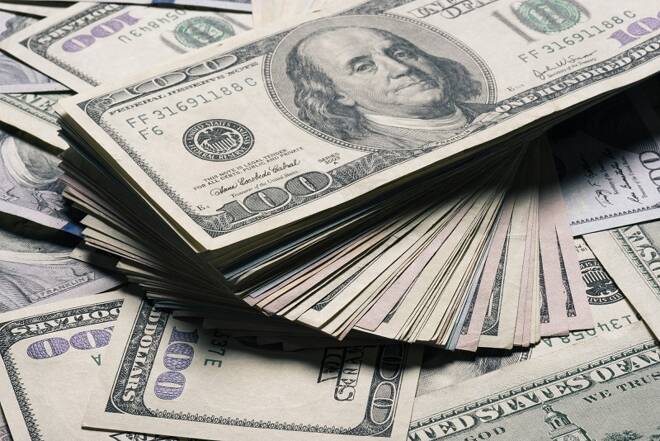Advertisement
Advertisement
Debt Ceiling Crisis Serves as Reminder Why the United States No Longer Has a AAA Credit Rating
By:
Amid another US debt-ceiling crisis, an expected last-minute avoidance of technical default would not be without consequences for the US’ creditworthiness.
Each debt-ceiling crisis imposes costs and damages the US’ reputation as a ‘risk-free’ borrower.
On Monday, a vote on a stopgap spending measure, packaged together with suspension of the debt ceiling, was blocked in the Senate. So, the US enters a critical phase of debt repayment risk entering October as the federal government’s cash resources diminish, and with federal deficits significantly higher than normal in 2021. Wider deficits curtail the time the US Treasury has for emergency action in meeting government spending obligations. Treasury’s cash balance stood at USD 0.3trn on 20 September, down from USD 1.6trn in February.
Expectation debt ceiling to be raised or suspended under party-line vote at the last moment
We expect the US government to raise or suspend the debt ceiling under a party-line vote in the end, thereby avoiding a sovereign credit default.
Nevertheless, the last-minute nature of any legislation sidestepping temporary default would remind investors of the significant, recurring risk to the willingness and capacity of the US to meet its debt obligations due to the debt ceiling.
Scope does not rate the United States as a AAA, risk-free sovereign issuer
Not only does Scope Ratings – the European rating agency I represent – not rate the US as a AAA, risk-free sovereign borrower, but the debt ceiling represents the most relevant near- to medium-run downside risk to current AA credit ratings we assign.
To resolve the latest debt-ceiling crisis, congressional Democrats could first seek to delink the debt ceiling and pass a separate continuing resolution for the US government to be open (confronting a potential government shutdown on 1 October). Thereafter, the Democratic Party, holding a technical majority in both houses of Congress, could consider budget reconciliation as final recourse to delay the debt ceiling until after 2022 midterm elections – although the complex reconciliation process similarly presents a set of risks due to nearly two weeks’ time this may demand.
Should not assume debt-ceiling political stand-offs are inevitably resolved just in nick of time
This latest episode is a fresh reminder that debt-ceiling crises of 2011 or 2013 are anything but things of the past.
We ought, moreover, not simply assume debt-ceiling political stand-offs are inevitably resolved in the nick of time. After all, the only technical US government debt default of the post-war era occurred in 1979 precisely due to partisan use of the debt ceiling.
The frequency of such US debt-ceiling stand-offs and recurring possibility of temporary non-repayment – even if driven by a so-called ‘accidental’ credit event – weigh on the US credit ratings. No other sovereign rated AA by Scope experiences such frequent crises during which default is a real scenario, barring last-minute legislative action, or has experienced a post-war credit event.
Each debt-ceiling crisis brings avoidable market instability, damage to Treasury market
Alongside risk of technical default, each debt-ceiling crisis brings otherwise avoidable financial-market instability, raising operational expenses for markets and resulting in some degree of damage to the market for US debt. This is even accounting for likelihood the debt ceiling has some impact in limiting ambition of incumbent governments’ spending policies.
According to the Government Accountability Office, delays in raising the debt ceiling in 2011 raised funding rates, hiking borrowing costs by USD 1.3bn over the fiscal year. The Bipartisan Policy Center estimated that the 2011 crisis, over a lengthier 10-year period, raised borrowing costs an aggregate USD 18.9bn.
Even a ‘temporary’ default on treasury bills – similar to that of 1979 – could result in structural damage to treasuries’ status as the global benchmark ‘risk-free asset’. The reputation of the US may require time to recover from any credit-event scenario, even if extra interest costs incurred might ultimately prove manageable.
Debt-ceiling crises occur as status of the US as issuer of the global benchmark safe asset is attenuating
US debt-ceiling crises are also taking place while the status of the US as issuer of the global reserve currency and benchmark risk-free asset is slowly attenuating. Avoiding debt crises is crucial to avoid any acceleration of this process.
This is leaving aside short-run repercussions of any credit-event scenario as regards undermining economic sentiment and growth – the latter which we estimate at a robust 6.2% for 2021 before 4.8% for 2022.
Debt-ceiling risks could further increase after 2022 midterm congressional elections
Risk associating with the debt ceiling could, furthermore, further elevate over the future, such as after midterm elections – should Democrats lose control of Congress. The experiences of 2011 and 2013 debt-ceiling crises demonstrate that risks were near heights when a Democrat President faced instead a divided Congress – and was, as such, absent recourse to a party-line congressional vote to raise (the debt ceiling), instead requiring a fraught bipartisan solution.
For a look at all of today’s economic events, check out our economic calendar.
Dennis Shen is a Director in Sovereign and Public Sector ratings at Scope Ratings GmbH.
About the Author
Dennis Shencontributor
Dennis Shen is the Chair of the Macroeconomic Council and Lead Global Economist of Scope Ratings based in Berlin, Germany.
Advertisement
